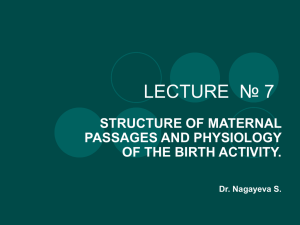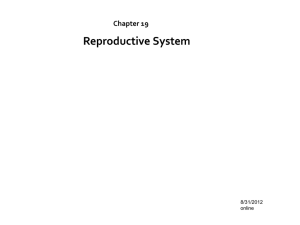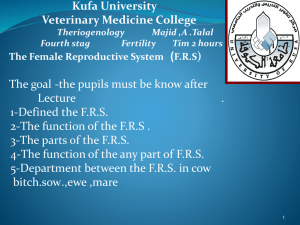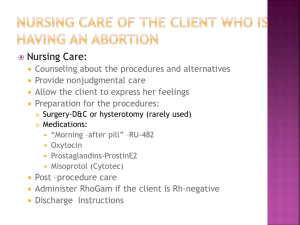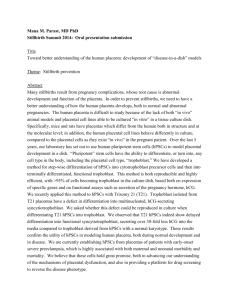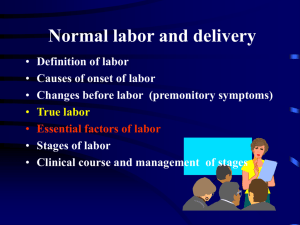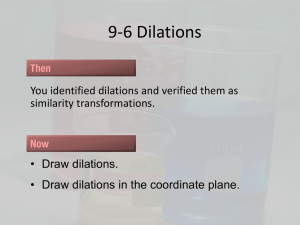contractions
advertisement
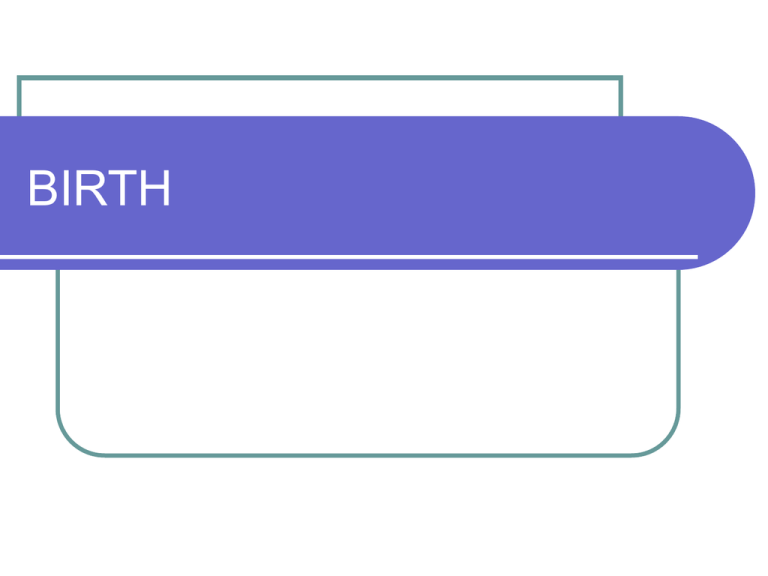
BIRTH Recognition of Labor Contractions are: regular in frequency intermittent in character at intervals of 10 minutes or less each lasts 30 seconds or longer “Bloody Show” Small amount of bloody discharge from the vagina This is the operculum releasing due to dilation of the cervix What is “False Labor”? signs of what appears to be uterine contractions getting stronger may be painful and may be at or near the EDD How can you tell? FALSE LABOR TRUE LABOR Irregular contractions Regular contractions No “show” “show” No progressive dilation or Progressive dilation and effacement of the cervix effacement of the cervix Palpation of the Cervix Assessing effacement and dilation… Palpation of the Cervix Ascertain the specific amount of dilation ripeness of the cervix full dilation (10 cm) and effacement If done too frequently can cause infection introduces bacteria into an otherwise clean environment Uterine Contractions Uterine muscle fibers are unique, unlike any other muscle in the body Regular muscle fibers get shorter during contraction and return to their normal length after the contraction The purpose of the uterine contraction however necessitates a different action the baby has to be pushed out… Uterine Contractions So instead… After the uterus contracts, the muscle fibers stay shortened during the relaxation phase Pressure is maintained on the cervix Dilation takes place slowly but progressively Uterine Contractions This process is called “retraction” Progressively reduces the capacity of the uterus eventually pushes the baby out Uterine Contractions The cervix (the lowest part of the lower pole) does not contract primarily a fibrous connective tissue (not muscle) The contractions of the upper pole causes retraction of the tissues of the lower pole stretch and thin out = effacement & dilation Effacement & Dilation As the cervix thins, the internal os is retracted up the sides of the uterus The external os is loosened and begins to dilate allowing the operculum to dislodge ~> “Bloody Show” Dilation and the Forewaters Thinning of the cervix and dilation of the external os allows the amniotic fluid in front of the baby’s head to protrude This is known as the “forewaters” or the “Hydrostatic Dilator” Dilation and the Forewaters “Hydrostatic Dilator” = fluid trapped between the head and the sides of the birth canal Hydrostatic Dilator Function protects the baby’s head during the dilation process does not let the head push directly on the cervix Stages of Labor Labor is a process… Stage 1 Begins with the onset of regular contractions Ends with the full dilation of the cervix Stage 1 Takes about 8-10 hours (multiparous) or 12-24 hours (primigravida) “Transition” Second Phase of Stage 1 This is the most physically and emotionally taxing phase of labor Cervix is opening from 8-10 centimeters Uterus is contracting strongly May enter an emotionally vulnerable state of exhaustion and exhilaration Stage 2 Begins with full dilation of the cervix Ends with the birth of the baby Generally takes from 10-60 minutes (1 hour) Contractions become more powerful… Urge to bear down or push She may want to hold her breath through the contractions She may become nauseated and vomit She may feel like she has to have a bowel movement May inhibit her pushing… Stage 2 Mechanisms of Birth AKA Cardinal Movements Mechanisms of Birth The baby has to make its way down and out of the birth canal by fitting its head and body through narrow passages The baby must twist and turn along the path of escape known as the “Cardinal Movements” Obstetrics Illustrated (1998) I II III IV V VI Flexion Descent Internal Rotation Delivery of the Head Restitution External Rotation Stage 3 Stage 3 Begins with the birth of the baby Ends with the birth of the placenta Generally takes about 5-50 mins. (1 hour) Placental Birth Placental Birth After delivery of the baby the uterus and vagina become loose and slackened soft to external palpation The site of the placental attachment is harder and firmer and may be palpable NOTE The placenta is usually attached to the anterior superior portion of the fundus of the uterus This will depend on the shape of the uterus and the position of the uterus at the time of implantation **Normally the uterus is slightly anti-flexed and the blastocyst falls onto the anterior superior wall Placental Birth Normally the placenta will dislodge from the uterine wall with uterine contractions or massage of the uterus Signs of Placental Detachment The fundus becomes narrow, hard and ballotable Slight bleeding occurs again (bleeding has stopped from the birth) The cord becomes longer Credes’ Method Apply gentle pressure on the fundus while pulling on the cord gently the cord will usually lengthen out of the vagina with this process Releasing pressure on the fundus will then show one of two things either the cord retracts back into the vagina indicating it has not detached or it will remain lengthened out of the vagina indicating it has detached Note… It is not a good idea to pull or tug on the cord to remove the placenta tearing of the placenta from the fundus (prior to cessation of uterine arterial flow to the placenta) could cause severe bleeding and possibly death Blood Loss Blood loss should be noted normally 250 ml (cup) will be lost during the placental delivery Any excessive bleeding should be taken as a sign of retention of placental parts until otherwise determined After Care… Stage 4 Stage 4 Begins with the birth of the placenta Ends with the recovery of the new mother Lasts for about 4 –6 hours Consists of close observation monitoring vital signs; excessive uterine bleeding After the placenta is delivered… The vagina and labia are inspected for tears or other general injuries provide the appropriate care may include suturing tears and episiotomies The placenta must also be inspected for appearance and completeness suspicion of any missing pieces necessitates inspection of the uterus Placental Types Disperse Battledore Circumvallate* Succenturiate* Bipartite/Tripartite* Magistral Fenestrate Duplex* Vellamentosa some are at higher risks for retention of placental parts* fenestrate may look like a retained placenta even if it is not (false finding) Retention of Placental Parts Retention of part or all of the placenta usually causes bleeding may be severe enough to cause death There are cases when it does not immediately cause a problem If parts are retained for a period of time, eventually… infection or immune reaction Retention of Placental Parts Management D&C (dilatation and curettage) needs to be performed remove the offending parts
